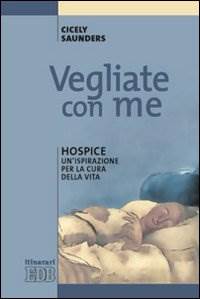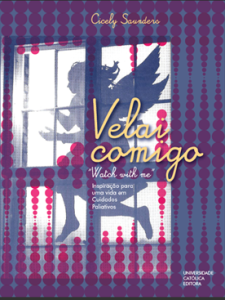
Last week I gave a lecture at the University of Navarra on the life, the work and the legacy of Cicely Saunders. The lecture focused in particular on the religious and spiritual journey that Cicely Saunders made over a personal and professional lifetime and how it paralleled her work in hospice and palliative care. I tried to show how this had taken her from a somewhat evangelical Christian starting point – from which care of the dying might be a vehicle for rescuing souls lost to God – to a much wider religious and spiritual perspective, still based in Christian belief, but encompassing notions of person-hood, inter-subjectivity and efforts to understand the meaning of suffering. One illustration of this is the book, Watch with Me, that she and I compiled together and that was published in 2003, two years before she died.
How the book came about
The idea for the book came after Dame Cicely gave me a copy of a lecture that she had given at Westminster Cathedral in June 2003 – and asked me if it could be published somewhere. I read it with interest but concluded that it would be better as part of a small collection of similar writings. I read through her relevant past publications and identified four other pieces that I thought worked together in a complementary way. Surprisingly it turned out that they were each written in a different decade, from the 1960s onwards. Cicely was happy with the choice, so I set up a small imprint to publish the collection privately, took the cover photograph myself and designed how the book should look. It came out in 2003 and over time two full print runs were sold, of about 3,000 copies in total.
Translations and wider interest
In 2008, the Milan based palliative care physician, Augusto Caraceni , together with colleagues, produced an Italian edition. The next year, 2009, a Swiss pastor and postgraduate student Martina Holder-Franz translated it into German. Spring of 2011 on a glorious day in Majorca, saw the launch of the Spanish edition, translated by Marisa Martin, Susan Hannam, Carlos Centeno and Enric Benito. Towards the end of 2013 the Portuguese edition was published, translated by Francisco Galrica Neto and with revisions and a preface by Isabel Galrica Neto. There are now plans to bring out an edition in Latin America. Watch with Me has been widely cited and well reviewed. Reena George, writing in the Indian Journal of Palliative Care described it as ‘a unique source of inspiration and information for anyone interested in palliative care’. There is every chance that other editions and translations will appear in the future and I am always happy to help with any practical arrangements to that end.
Key themes of the book
Running through each of the five chapters of Watch with Me is the relationship between personal biography, the emergence of the spiritual life and a deep concern with the ethics of care.
The eponymous opening chapter is taken from a talk given at the AGM of St Christopher’s Hospice, in 1965 – two years before the hospice opened. It is about foundations – material, practical and above all the foundations of care, taken from words spoken by Christ in the Garden of Gethsemane. It sums up the demands that will lie ahead – and the importance of ‘being there’. The second chapter, from 1974, is about faith and takes its inspiration from patients at the hospice. It also chimes with the mood of the day, quoting Tolkien’s metaphors of quest to demonstrate how, despite the worst adversities, ‘release comes unexpectedly and in the end all are seen to have played a part’. Faith, she says, can be about letting go as well as receiving with open hands.
‘Facing death’, the third chapter, was written for a Catholic journal in the 1980s. It is a reflective piece containing the distillation of decades of personal experience in caring for dying people: ‘To face death is to face life and to come to terms with one is to learn much about the other’. ‘A personal therapeutic journey (chapter four) is a well known piece that first appeared in the Christmas edition of the British Medical Journal in 1996 and has been much enjoyed. It takes us to the wards of St Thomas’ Hospital in World War Two, to reflections on the armamentarium of the day (including the Brompton Cocktail) and then on to the path breaking concept of ‘total pain’, which she first described whilst working at St Joseph’s Hospice in the early 1960s.
The collection concludes wonderfully with ‘Consider Him’, where Cicely Saunders outlines for readers new and old the elements that make up her modern philosophy of care for those at the end of life – along with its sources, inspirations and dilemmas. She acknowledges that ‘Hospice and palliative care today is carried out by many people who find that religious answers do not speak to them. Nevertheless they give much spiritual help. When I asked our chaplain what was the real foundation for his work, he said simply brokenness‘. She has traveled a long way in her thinking and beliefs from the beginning of the book where her main concern is to take a biblical text and apply it to the work of the hospice. The journey is fully revealed in five short chapters and stands as a remarkable testimony to faith and work in the life of one person.
Continuing worth
Watch with Me is now out of print in English and hard-to-come-by second hand copies trade well above their modest initial price. Whether or not one shares its specifically Christian outlook (which I do not) its 50 pages still contain much to inspire those interested in the work of hospice and palliative care around the world today. It is also important as a link to the origins of a modern movement, which could all too easily disengage with its founding vision and ideals. To that extent some have called it essential reading for nurses, doctors and others who are training for work in palliative care. As I have found in writing this post, it also repays re-reading.
If there is interest I could perhaps find some way to put up an open access copy of the original English version. If you are fortunate enough to have a copy already, take it out over the Easter weekend and explore the rich messages that Watch with Me still has to offer.
David Clark, 15 April 2014






Thanks David for reminding me of this book. I bought several copies and tok them to Uganda and gavre to many. But I had forgotten about it and its wisdom and think I may even have given away my last copy. I would be derlighted to have access to a copy on line!
Please let me have a copy of this book on line .
You can find it here – http://wp.me/p4mczF-44
DC
Update: An open access PDF copy of Cicely Saunder’s Watch with Me is available on this blog
[…] años después, mi querido amigo David Clark me regaló la primera edición de “Watch with me” (Velad conmigo), una pequeña monografía con cinco conferencias de Cicely Saunders y me propuse […]